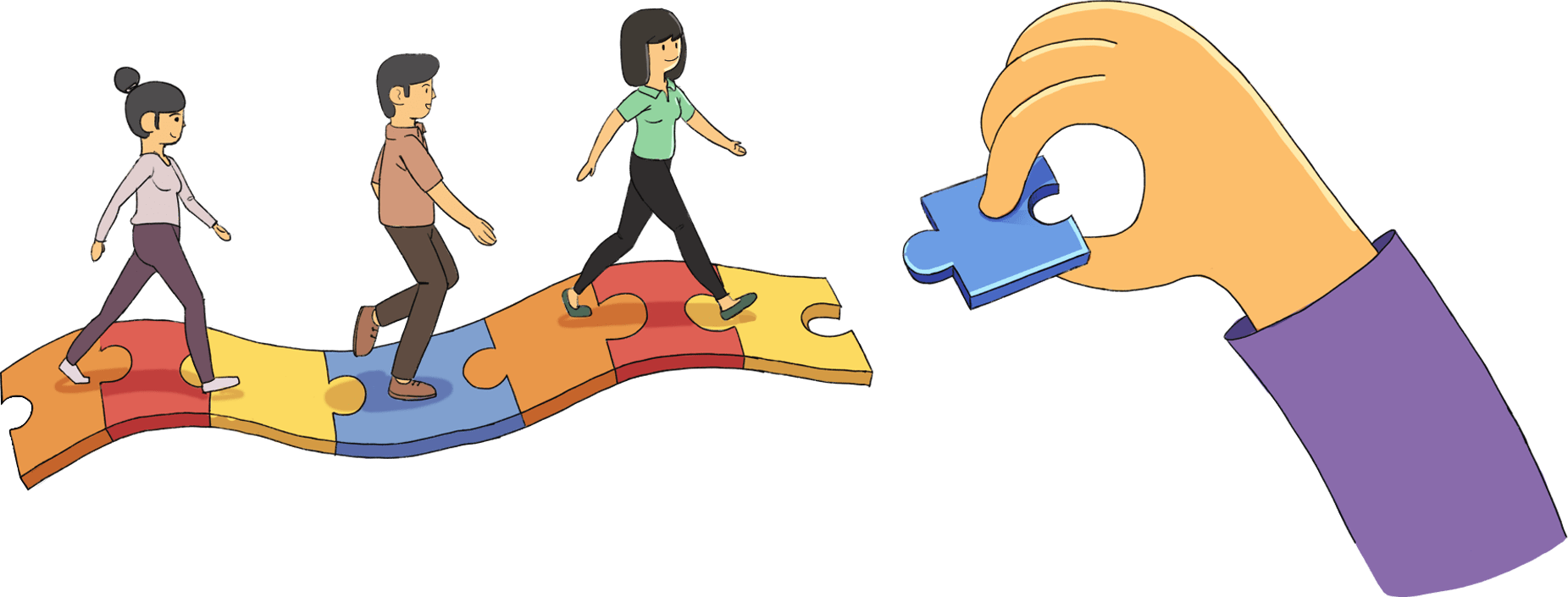
Stakes are too high for the 8-year old Gaana to now start losing marketshare to rival music streaming companies in India. Here's how it plans to fend off competition.
The biggest companies have entered India’s music streaming market in the last few months. The $25.67 billion streaming company Spotify launched in India in January. Youtube Music launched earlier this month. Reliance Jio acquired homegrown streaming service Saavn in a deal valued at over $300 million in March last year.
If Prashan Agarwal, the chief executive of India’s largest music streaming company Gaana is getting the jitters, he isn’t showing much of it. “The competition will help grow the market. We will continue to lead the market,” Agarwal tells me on Friday at the company’s Noida headquarters where close to 200 people work. Next door is Times Internet Ltd, Gaana’s parent company with a growing portfolio of internet firms and part of media giant, The Times Group.
Last year February Gaana said it has raised $115 million in a funding round led by Chinese internet major Tencent. As per one source, the company was valued at over $350 million. To put that in context, Saregama, one of India’s largest record labels (not apples to apples, yes) has a market cap of about $150 million. The stakes are too high for the 8-year old Gaana to now start losing marketshare to rivals. It has about 80 million monthly active users.
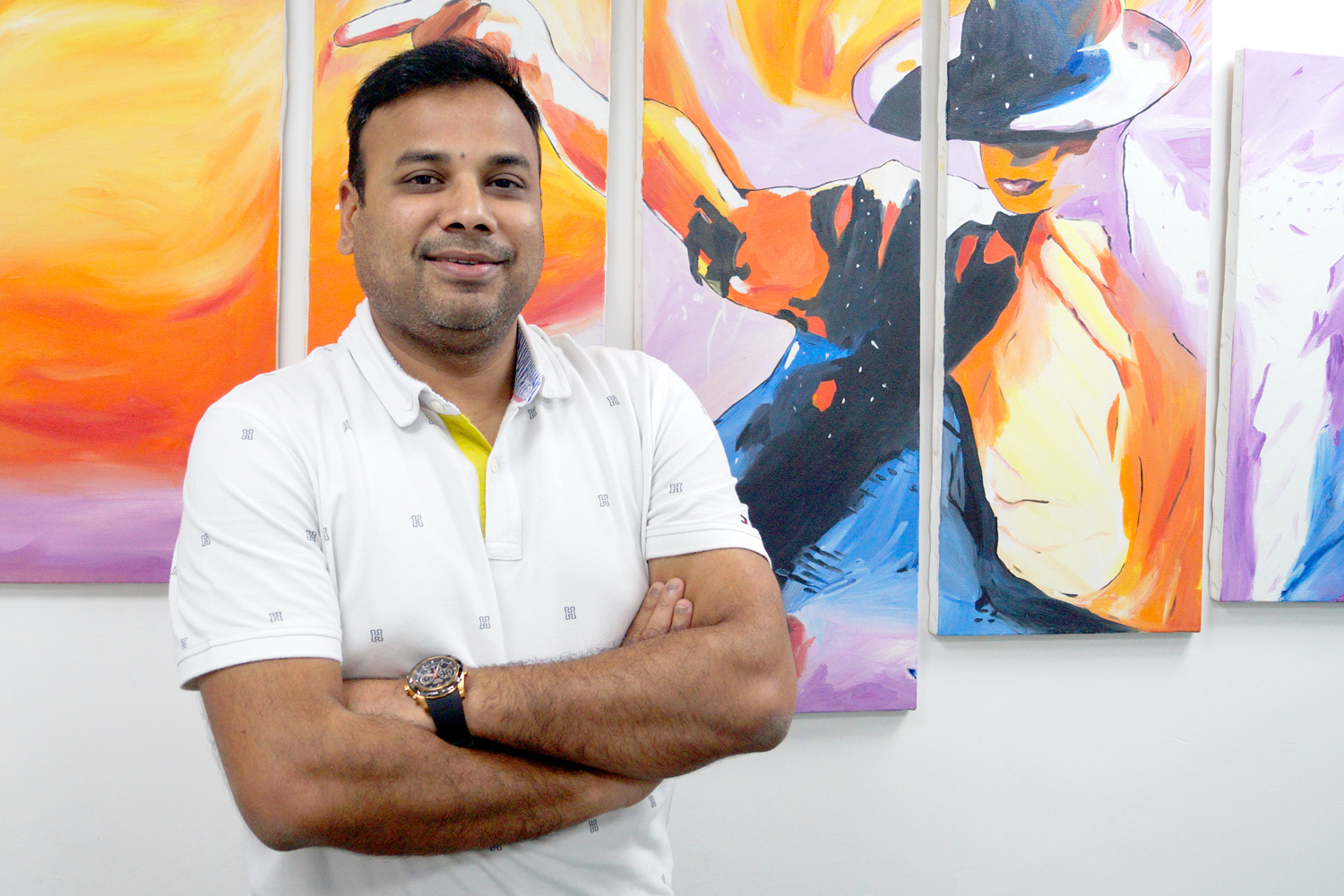
With the number of online users expected to grow to 840 million by 2022 from 446 million now and only about 150 million streaming music consumers, there’s headroom for everyone to grow. Nevertheless, Spotify acquired a million users in just 3 days of launch even without high decibel advertising campaigns, underscoring the fact that existing users will switch platforms in a blink.
“We’ve seen tremendous response since the launch, not just in terms of numbers but also in terms of chatter and engagement with the brand outside of the platform on social media,” says Akshat Harbola, head of marketing operations, Spotify India.
To protect its lead and grow its valuation, Gaana needs to fend off new entrants and also homegrown rivals such as JioSaavn and Wynk Music. I start my hour-long conversation with Agarwal with a “so, what’s the plan” question.
The short takeaway: Gaana is building product features on top of the data it has amassed over the years, pushing deeper into regional language content, launching exclusive music and videos and even reaching the offline audience at pubs and events.
Two years ago the Noida headquartered company launched its app in 12 languages. “We wanted to be a platform for the entire country and regional was a big part of it,” says Agarwal. Last year, as more and more people from smaller cities and towns came online for the first time, thanks to plummeting data prices, Gaana integrated voice search into the app using Google’s speech engine. Nearly 25%, or about 20 million, users on Gaana use voice search now. Launching voice search also makes it easier for Gaana users who consume content in over 30 different languages. Four months ago, the company also integrated lyrics to the app so a user can see the lyrics while a song is playing.
Gaana also drives nearly 15% of consumption using recommendation engines it has built. “The understanding of Indian music and content we have built is big,” says Agarwal. “We’ve invested close to 2.5 years understanding user consumption.”
This is an area where Spotify may take time to catch up to Gaana. “Unless they (Spotify) acquire users from all geographies and economic classes, they will not have the data to build the recommendation engine fast,” says Rohit Bhatia, former CEO of Dhingana, an early streaming music company which shuttered in 2014.
Gaana has one of the largest number of consumers of English, Hindi and Punjabi music. “We’ve done a lot of exclusive content in Punjab and that strategy has paid well for us,” says Agarwal. Nearly 33% of content consumed on Gaana is regional languages, about 50% is Hindi (including Bollywood) and the rest is split between English and other languages.
In total, users stream songs nearly 2.7 billion times on Gaana. Some of the biggest Punjabi hits of 2017 included Gaana exclusive songs like Putt Jatt Da and Guitar Sikhda. Original songs created for Gaana have also paid off well for the platform. For instance, a song called “Tera Ghata” has been played over 100 million times on Gaana and Dilbar, the biggest Bollywood hit currently, has been played about 145 million times. The idea is to now replicate Gaana’s success with originals and exclusives in Punjabi in other languages including Tamil, Telugu, Marathi and Bhojpuri. The streaming company is also planning television campaigns in local languages.
The company also wants to launch music videos on the platform. Gaana is building its own music video library as a supporting experience to increase engagement and advertising revenues, The Ken reported (paywalled) earlier this month.
In 2018, Gaana also quietly acquired a company called Jukebox Studio. With that acquisition, Gaana now powers the music in about 5,000 offline locations like pubs and bars. “We will scale that to 30,000 pan India,” says Agarwal. The company has also started running small events and music festivals.
The Indian music segment grew 10% to reach Rs 1,420 crore in 2018. It is expected to grow 10.8% for the next two years as digital revenues, performance rights and synchronization rights bring in more money, according to a report on India’s media and entertainment sector titled: A billion screens of opportunity (pdf). The report, by FICCI and EY, published earlier this month points out that audio streaming grew a healthy 50% to reach 150 million listeners in 2018.
But if you go deeper, there are problems for streaming companies including the rising cost of licensing music, anaemic subscription revenues, a shallow advertising market, and players that are better integrated vertically with distribution channels.
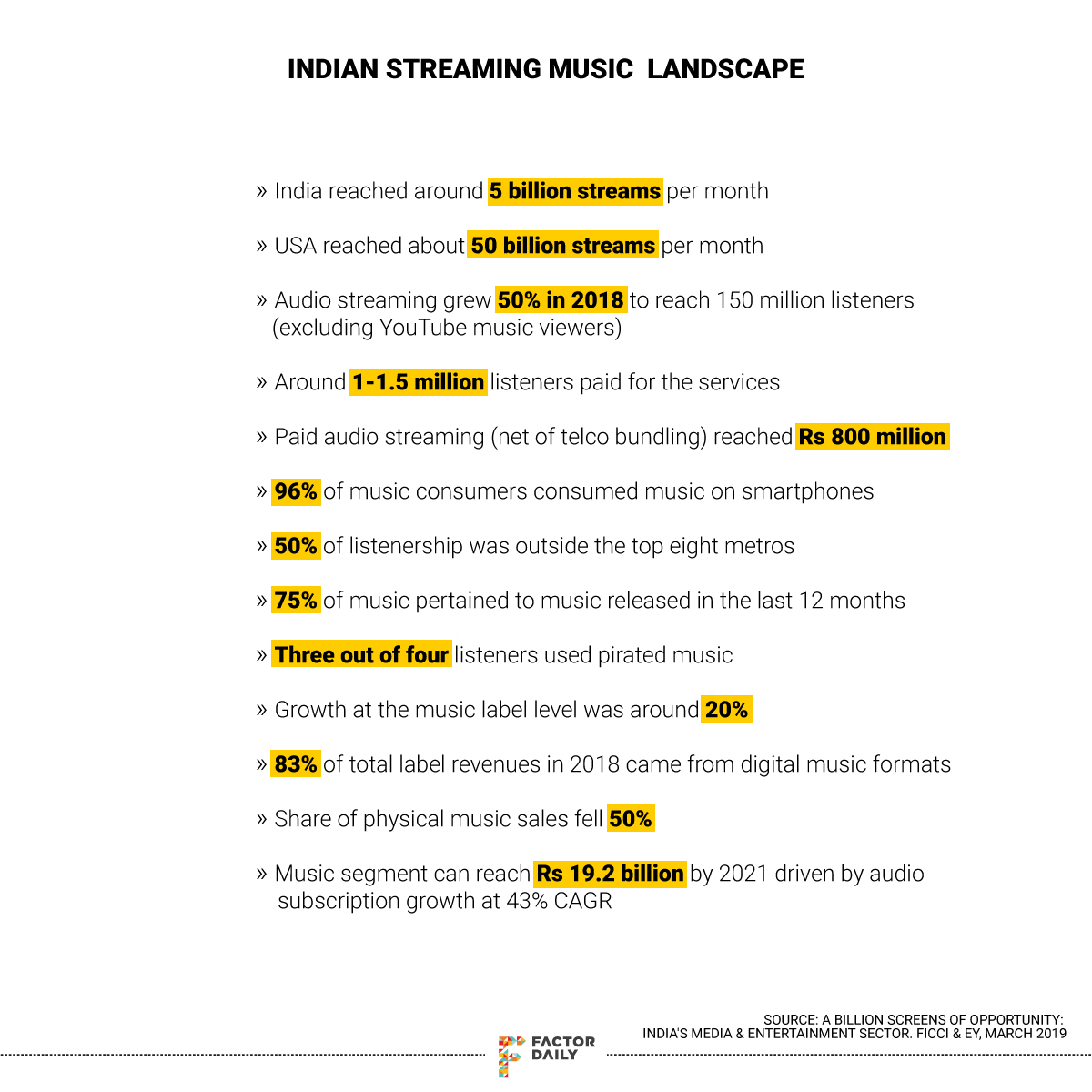
The cost of running a music streaming platform could go up to $30 million -$35 million a year if you include the cost of licensing from major record labels like T-Series, Sony and Universal Music; operations and infrastructure. As competition grows, licensing costs are only likely to go up. Music labels not only extract a minimum guaranteed price from licensees but also charge per stream if it exceeds a cap. This also means the more users you acquire, the more your costs. In an ideal world, this would have been a good problem to have. Because more users would mean more money right? But in India, people are hardly willing to pay for music.
Bhatia does a back of the envelope calculation to explain why it’s hard to sustain such high costs: Even if Spotify manages to get 10 million users in a year, and about 10% of these users are paying users (about 1 million) who pay about Rs 1,189 ($17) for a year, the company will barely recover half the money it shovelled into the business.
“The problem with freemium models in India is that once you offer services for free it is very difficult to convert those users into paying customers,” says Bhatia, who now runs fintech company PayLatr. Premium pricing works for Netflix, because of its strategy to pursue originals. Netflix spent close to $8 billion on original content in 2018. “Since they are produced in-house, Netflix doesn’t need to bear licensing cost for this content. For a music streaming player, most of its content is licensed,” says Bhatia.
For a ‘glass half empty’ view, look at the FICCI- EY report: Less than 1% out of 150 million odd listeners paid for the services. Paid audio streaming, including bundles sold through telecom networks, was a measly Rs 80 crore (~$11 million). Agarwal declined to share the number of paying subscribers on Gaana.
Gaana sees itself as a distribution platform. So it’s unlikely to get into the business of producing music. But if the fight for exclusive brands we saw in the e-commerce industry has taught us anything, it can become a bargaining chip for record labels who will look to sell to the highest bidder or even launch their own products. That will also risk driving up the price as platforms like Spotify and Gaana fight over exclusives. Agarwal believes that Gaana’s distribution strength and the Times Group’s relationships with artists and labels through its media publications will help ring-fence exclusive content even if a new entrant were to throw money at it.
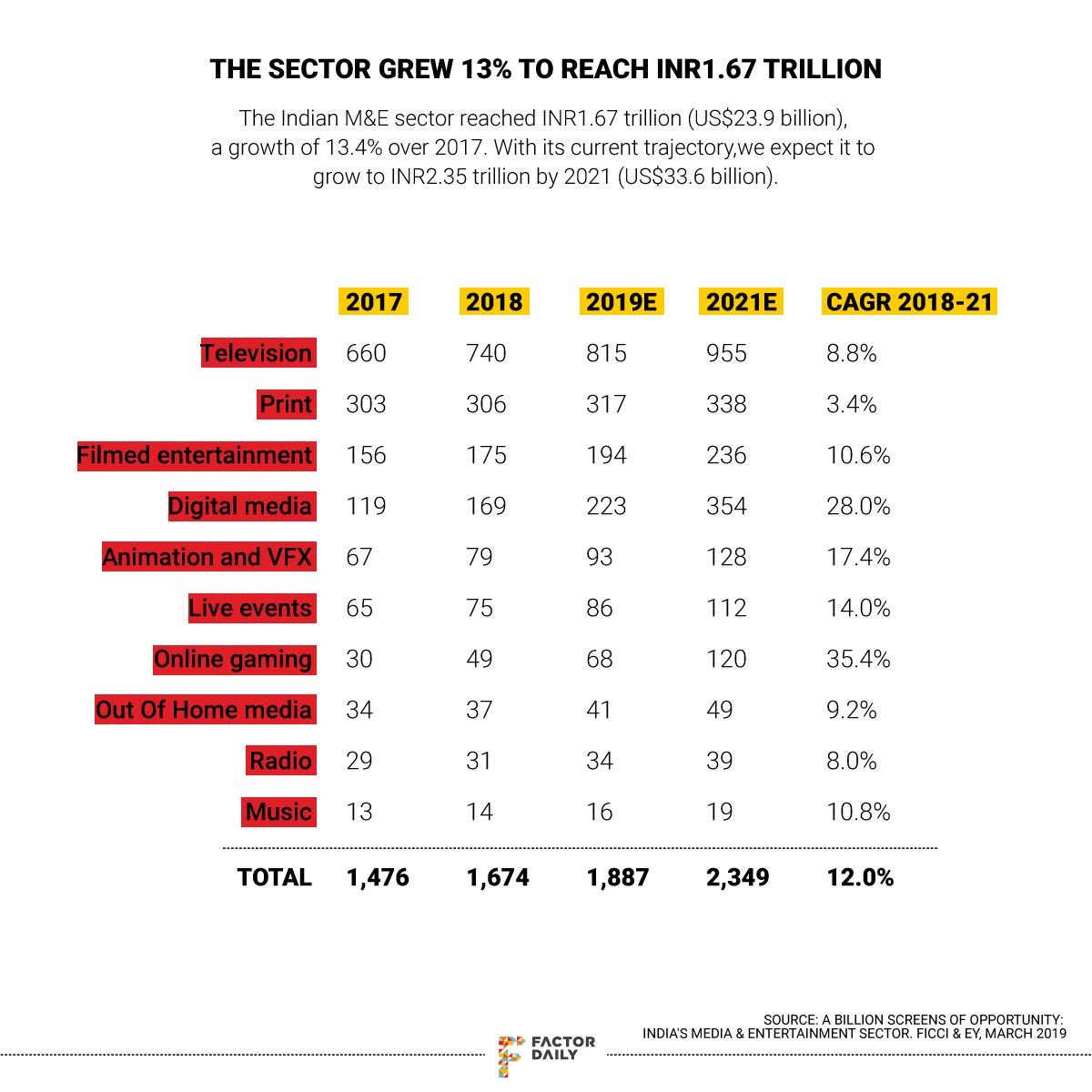
Industry executives also hope that a large portion of radio ads which make up about Rs 3,100 crore (~ $450 million) of advertising spends a year, will move to audio streaming apps that allow better targeting of users. Yet, monetisation will remain a challenge for these players.
If subscriptions don’t pay the bills, platforms will have to sell more ads. But selling more ads means more interruptions and hence higher chances of losing a user to a competitor. “The concept of brand loyalty in music streaming in India almost doesn’t exist,” says Bhatia who added that among the players, Gaana has the best chances of bringing in advertising revenues.
One has to only see the sales deck of JioSaavn to know how closely streaming app companies track each other. JioSaavn, which claims to have about 22 million monthly active users (2 million abroad), also claims that it is different because it has a strong UI/ UX, hundreds of record labels, voice integration, original programming and artist tie-ups.
“Gaana’s parent Times internet makes it an easy option for advertisers and the company to find advertisers. They have a big ad team in place, that pitches for Gaana among a host of its other properties,” Bhatia said.
One way out of the pricing problem could be to follow Steve Jobs and the iTunes model. Harvard professor Bharat Anand calls this the “complements” strategy. Between 2002 and 2013, at about 99 cents a piece, iTunes generated revenues of about $10 billion. “Roughly 70 of the 99 cents charged went to the recording studio, with another 20 cents going to credit card processing fees leaving Apple about a dime for overheads,” Anand writes in his book The Content Trap. The idea was to use songs on iTunes as a complement to iPods. “The “bill of materials” for a $250 iPod was only about $130, leaving an astounding profit margin. In other words, pricing songs low wasn’t a strategy to give away profits to consumers. It was a strategy to make even more profits elsewhere,” writes Anand.
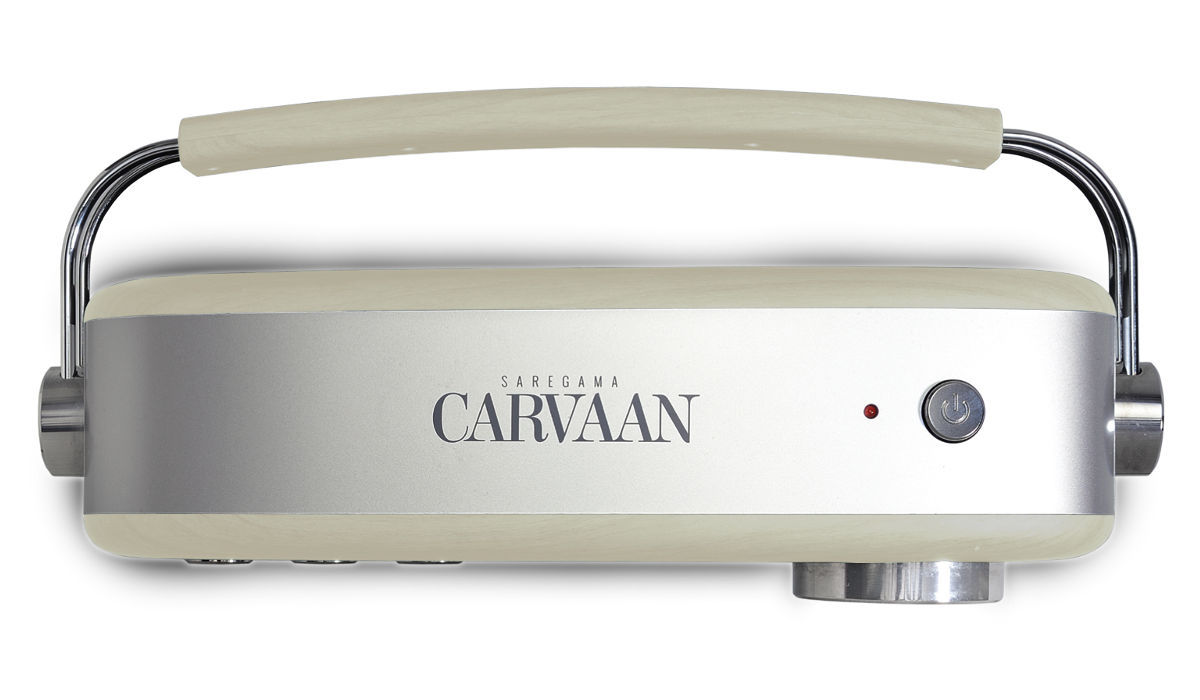
In India, a similar play was pulled off by Saregama, one of the country’s oldest record labels. In 2017, the company launched Carvaan, a digital music player priced upwards of Rs 5,000 and bundled it with thousands of free songs. The product was an instant hit and the company sold over a million unit in a little over a years time.
Also see: How data is helping India’s oldest music company Saregama revive its fortunes
Similarly, for telecom companies, music streaming could be seen as a complement. “A bundled offering of data pack with music streaming is lucrative to customers and works for the telco providers,” says Bhatia. Here telecom players like Airtel and Jio which own music streaming apps Wynk and JioSaavn respectively, have a clear advantage over Gaana.
Streaming app companies aren’t likely to worry about monetisation as yet because now is the time to acquire users. “The market will grow from 150 million to 400 million users much faster than it grew from 35 million to 150 million users. In the next 2-3 years, we should be at the 400 million mark,” says Agarwal.